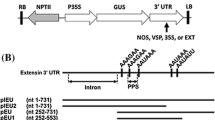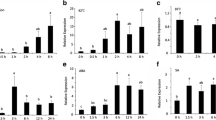Abstract
Experiments conducted in vitro using the electrophoretic mobility shift assay have shown that a single region of the extensin gene of carrot (Daucus carota L.) interacts with a protein factor designated Extensin Gene Binding Factor-1 (EGBF-1) present in nuclear extracts obtained from carrot roots. This interaction is sequence-specific as judged by the failure of other plant gene sequences to compete with the extensin gene for EGBF-1 binding. The EGBF-1 activity is organspecific, not being expressed in nuclear extracts obtained from carrot leaves or stems. Both ethylene treatment and wounding of roots are shown to have a controlling influence on the expression of EGBF-1 activity in nuclear extracts. These results demonstrate that at least three distinct signals: ethylene treatment, wounding, and development, are important in determining the activity of EGBF-1 in nuclear extracts, and indicate a role for EGBF-1 in stress-related signal transduction and the regulation of extensin-gene expression.
Similar content being viewed by others
Abbreviations
- bp:
-
base pair(s)
- EGBF:
-
extensin-gene binding factor
- EMSA:
-
electrophoretic mobility shift assay
- HRGP:
-
hydroxyproline-rich glycoprotein
- kb:
-
kilobase
References
Baeuerle, P.A., Baltimore, D. (1988) Activation of DNA-binding activity in an apparently cytoplasmic precursor of the NF-κ B transcription factor. Cell 53, 211–217
Bradford, M.M. (1976) A rapid and sensitive method for the quantitation of microgram quantities of protein utilizing the principle of protein-dye binding. Anal. Biochem. 72, 248–254
Brand, A.H., Micklem, G., Nasmyth, K. (1987) A yeast silencer contains sequences that can promote autonomous plasmid replication and transcriptional activation. Cell 51, 709–719
Chalutz, E. (1973) Ethylene-induced phenylalanine ammonialyase activity in carrot roots. Plant Physiol. 51, 1033–1036
Chen, J., Varner, J.E. (1985) An extracellular matrix protein in plants: Characterisation of a genomic clone for carrot extensin. EMBO J. 4, 2145–2151
Deikman, J., Fischer, R.L. (1988) Interaction of a DNA binding factor with the 5′-flanking region of an ethylene-responsive fruit ripening gene from tomato. EMBO J. 7, 3315–3320
Dron, M., Clouse, S.D., Dixon, R.A., Lawton, M.A., Lamb, C.J. (1988) Glutathione and fungal elicitor regulation of a defense gene promoter in electroporated protoplasts. Proc. Natl. Acad. Sci. USA 85, 6738–6742
Ecker, J.R., Davis, R.W. (1987) Plant defense genes are regulated by ethylene. Proc. Natl. Acad. Sci. USA 84, 5202–5206
Ephrussi, A., Church, G.M., Tonegawa, S., Gilbert, W. (1985) B-lineage-specific interactions of an immunoglobulin enhancer with cellular factors in vivo. Science 227, 134–140
Godowski, P.J., Rusconi, S., Miesfeld, R., Yamamoto, K.R. (1987) Glucocorticoid receptor mutants that are constitutive activators of transcriptional enhancement. Nature 325, 365–368
Jofuku, K.D., Okamuro, J.K., Goldberg, R.B. (1987) Interaction of an embryo DNA binding protein with a soybean lectin gene upstream region. Nature 328, 734–737
Kahl, G., Laties, G.G. (1989) Ethylene-induced respiration in thin slices of carrot root. J. Plant Physiol. 134, 496–503
Karlin-Neumann, G.A., Kohorn, B.D., Thornber, J.P., Tobin, E.M. (1985) A chlorophyll a/b-protein encoded by a gene containing an intron with characteristics of a transposable element. J. Mol. Appl. Genet. 3, 45–61
Lawton, M.A., Lamb, C.J. (1987) Transcriptional activation of plant defense genes by fungal elicitor, wounding, and infection. Mol. Cell. Biol. 7, 335–341
Lee, W., Mitchell, P., Tjian, R. (1987) Purified transcription factor AP-1 interacts with TPA-inducible enhancer elements. Cell 49, 741–752
Liamins, L., Holmgren-Konig, M., Khoury, G. (1986) Transcriptional “silencer” element in rat repetitive sequences associated with the rat insulin 1 gene locus. Proc. Natl. Acad. Sci. USA 83, 3150–3155
Lieberman, M. (1979) Biosynthesis and action of ethylene. Annu. Rev. Plant Physiol. 30, 533–591
Lycett, G.W., Croy, R.R.D., Shirsat, A.H., Boulter, D. (1984) The complete nucleotide sequence of a legumin gene from pea (Pisum sativum L.). Nucleic Acids Res. 12, 4493–4506
Maniatis, T., Fritsch, E.F., Sambrook, J. (1982) Molecular cloning: A laboratory manual. Cold Spring Harbor Laboratory, Cold Spring Harbor, N.Y. USA
Nichols, S.E., Laties, G.G. (1984) Ethylene-regulated gene transcription in carrot roots. Plant Mol. Biol. 3, 393–401
Odell, J.T., Nagy, F., Chua, N.H. (1985) Identification of sequences required for activity of the cauliflower mosaic virus 35S promoter. Nature 313, 810–812
Oh-Lee, T.M., Turgeon, R., Wu, R. (1988) Interaction of a gibberellin-induced factor with the upstream region of an α-amylase gene in rice aleurone tissue. Proc. Natl. Acad. Sci. USA 85, 6366–6369
Ryder, T.B., Hendrick, S.A., Bell, J.N., Liang, X., Clouse, S.D., Lamb, C.J. (1987) Organization and differential activation of a gene family encoding the plant defense enzyme chalcone synthase in Phaseolus vulgaris. Mol. Gen. Genet. 210, 219–233
Sen, R., Baltimore, D. (1986) Multiple nuclear factors interact with the immunoglobulin enhancer sequences. Cell 46, 705–716
Singh, H., Sen, R., Baltimore, D., Sharp, D. (1986) A nuclear factor that binds to a conserved sequence motif in transcriptional control elements of immunoglobulin genes. Nature 319, 154–158
Stafstrom, J.P., Staehelin, L.A. (1988) Antibody localization of extensin in cell walls of carrot storage roots. Planta 174, 321–332
Theologis, A., Laties, G.G. (1982) Potentiating effect of pure oxygen on the enhancement of respiration by ethylene in plant storage organs; a comparative study. Plant Physiol. 69, 1031–1035
Tierney, M.L., Wiechert, J., Plymers, D. (1988) Analysis of the expression of extensin and p33-related cell wall proteins in carrot and soybean. Mol. Gen. Genet. 211, 393–399
Watson, J.C., Thompson, W.F. (1986) Purification and restriction endonuclease analysis of plant nuclear DNA. Methods Enzymol. 118, 57–75
Wu, C. (1985) An exonuclease protection assay reveals heat-shock element and TATA box DNA-binding proteins in crude nuclear extracts. Nature 317, 84–87
Author information
Authors and Affiliations
Rights and permissions
About this article
Cite this article
Holdsworth, M.J., Laties, G.G. Site-specific binding of a nuclear factor to the carrot extensin gene is influenced by both ethylene and wounding. Planta 179, 17–23 (1989). https://doi.org/10.1007/BF00395766
Received:
Accepted:
Issue Date:
DOI: https://doi.org/10.1007/BF00395766




